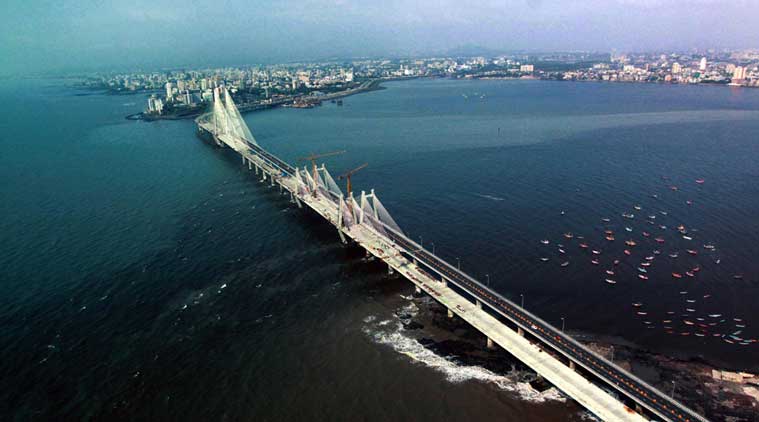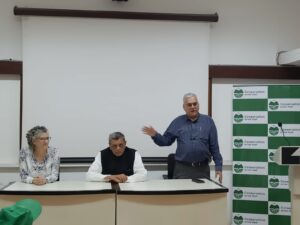Maharashtra’s road agency wants portion of Arabian Sea to be deemed as govt land
Sandeep A Ashar, The Indian Express, April 24 2018

The cash-strapped agency, which is in the process of building the 17.17-km long Versova-Bandra Sea Link (VBSL) off the Mumbai coast, has approached the chief minister-led urban development department with the proposal.
The cash-strapped agency, which is in the process of building the 17.17-km long Versova-Bandra Sea Link (VBSL) off the Mumbai coast, has approached the chief minister-led urban development department with the proposal.
The sea bridge, which is part of Mumbai’s coastal road project, is coming up 900 meters away from the Mumbai coast, and would involve piling on the sea bed and erected of piers for building the cable-stayed bridge. The construction project would also involve building dispersal points connecting the sea link to the main land at three different points along the route.
To raise resources for the project, the MSRDC has proposed that the area under water, being used for the construction, be deemed as government-owned land, and that the agency be permitted to lift development rights for this ‘land’ in the form of transferable development rights (TDR) and sold for use on a property within the Mumbai municipal limits.
According to Mumbai’s prevalent development control regulations, a private owner can avail TDR up to two times the land surrendered for a public amenity. He can further avail construction TDR, which is linked to the construction cost and the land cost, for construction of such an amenity himself, and handing it over free-of-cost to the municipality.
In a proposal dated December 14, 2017, MSRDC’s then managing director (MD), Dr Bhushan Gagarani, has pointed out that such TDRs can also be availed for lands under new roads or road widening projects proposed in the development plan.
When contacted, while MSRDC’s current chief executive Radheshyam Mopalwar sought time to share more details regarding the proposal, Gagarani was more forthcoming. “This is still a public transportation corridor, only that the construction is being taken up inside the sea. Our contention to the government was that a special dispensation should be made for the project, and permission for availing TDR for construction of public roads on the sea be allowed as well,” he said.
On how areas under water can be seen as land, the agency has another unusual explanation. The agency’s proposal to the UD department has invoked section 20 of the Maharashtra Land Revenue Code-1966, which essentially contends that the “all public roads, paths, lanes, bridges, ditches, dikes, the bed of the sea or harbours or creek below the high-water mark, which does not legally belong to any person must be vested in the state government, and that the Collector can dispose it off in any manner as prescribed by the state government”.
“On the basis of this provision, areas under the (Arabian) sea bed can be deemed to be ‘government land’. The MSRDC is of the view that the TDR can be availed for it,” the proposal states, while urging the state government to issue directives in this regard to the Mumbai municipality.
Considering that the acreage and the worth of the areas under water, which are put to use, cannot be measured, the MSRDC has proposed that the project’s construction area (roughly 60 lakh square feet) be treated as the land area, and it’s cost then be approximated on the basis of ready reckoner values of the proximal land areas. “Our estimate was that TDR worth Rs 2500 crore or so can be raised in this manner. This would help a great deal in the funding of the project,” said Gagarani.
The agency’s proposal has come at a time when the state government has planned to incentivise the construction TDR further in the city’s new development plan, which is expected to be unveiled in the coming few days.
Government sources, however, indicated that the proposal was likely to be shot down. “The MSRDC has already been communicated orally that it cannot be accepted,” said a senior official. The sop can only be extended to development plan roads, which the sea link is clearly not, he added.
The Mumbai municipality, which has also been asked to comment on the proposal, has also opposed it. The TDR provision is for private entities. It is not meant to be extended to government agencies building public roads, said a civic official.
However, the government has formulated an alternate plan for funding the project. With additional floor space index (FSI) to be made available in both the island city and the suburbs in the development plan, the government has imposed a rider that 25 per cent of premium payable will be ring-fenced for the VBSL.
The state government had approved MSRDC’s revised proposal and administrative cost for VBSL on December 4, 2017.
The corridor’s main purpose is to provide a direct link between the northern end of Mumbai and the Bandra-Worli Sea Link in order to reduce traffic congestion mainly in the western suburbs.

